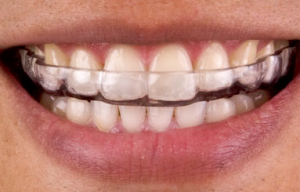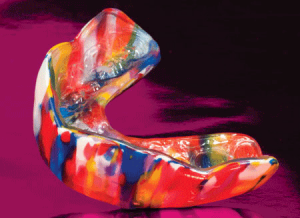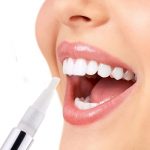What is Cosmetic Dentistry?
Cosmetic Dentistry is a specialized part of general dentistry, aimed at creating a positive change for a Patient’s smile. Cosmetic dentistry is much more than teeth whitening or porcelain veneers. The ideals of cosmetic dentistry address both a Patient’s functional and aesthetic concerns regarding their teeth, gums and overall oral health.
Bonding
Bonding teeth is a cosmetic dental procedure where tooth-colored, composite resin is utilized to sculpt the appropriate shape and size of the patient’s teeth. Dr. Malcomson can ‘build up’ a smaller tooth, so that it is equal in size to adjacent teeth.
This dental procedure is fairly simple and can be accomplished in a single office visit. Dr. Malcomson prepares the tooth’s surface to receive the bonding material and matches the shade of the bonding material to the patient’s natural tooth color. At this point, Dr. Malcomson will gently etch the tooth’s surface, apply a conditioning liquid, and the bonding process will begin. A curing light is used for polymerization of light cure, resin based composites.
Dr. Malcomson may recommend bonding, if you have a diastema (a ‘gap’ between two teeth). This can occur anywhere in the mouth. Generally, a diastema is found between the two front teeth. Although this area can potentially be distressing, it can be cosmetically treated. Dr. Malcomson can bond the teeth, eliminating the ‘gap’ and effectively camouflaging this undesirable space. There are a few things to think about before a patient has this treatment. If a patient enjoys large amounts of coffee, tea, red wine or smokes, the composite resin may become stained and ‘yellowy” over time. This makes bonding a less desirable treatment, eg. the material used for bonding is porous. If you are concerned about staining, Dr. Malcomson may recommend closing the ‘gap’ with porcelain veneers; which do not easily stain or discolor. Natural teeth discolor, so incorporating a whitening regimen will maintain shade consistency with bonding material and / or veneers.
TRUE: Bonding material isn’t as strong as your natural tooth. Patients who chew fingernails or pens, may chip the bonding material over time. However, if well taken care of, bonding will last for many years. If you are considering closing the ‘gap’, ask Dr. Malcomson at your next Hygiene appointment. A Treatment Plan will show all associated costs of this simple, yet cosmetically pleasing procedure.
Watch a Short Patient Education Video
Mouth Guards

Occlusal Guard (Night Guard)
An occlusal guard or splint can be recommended to patients who have needed restorative dental work. An occlusal guard will protect your restorations from possible clenching while sleeping. These types of restorations may include; crowns, bridges, and veneers. Apart from restorative dental work, jaw muscles may feel tired or sore upon waking, which might signal that you are grinding or clenching while you sleep. Over time, grinding can wear away natural tooth enamel and destroy natural tooth structure, necessitating restorative treatment(s). During your Hygiene appointment, ask Dr. Malcomson if an occlusal guard could help provide relief from night time grinding, bruxing and clenching. The most common type of occlusal splint is called a permissive splint. This is an appliance that may be fitted to either the upper or the lower teeth. The biting surface of a permissive splint is smooth and fairly flat. When the jaw closes, it can slide freely against the flat surface, leaving jaw muscles to move free of any deflective tooth inclines that can interfere with peaceful muscle activity. Patients who have a poor bite relationship; the jaw joints (TMJs) may have to be displaced from their sockets to make the teeth fit together when the jaw closes. Jaw muscles that have to hold the joints out of position every time the teeth come together, get tired and may become painful. If there are no structured disorders in the joints, the sore muscles become comfortable, usually within hours or, at most, two to three days, at which time the comfortable jaw to jaw relationship can be ascertained and the bite can be corrected.
Watch a Short Patient Education Video

Athletic Mouthguard
Athletic mouthguards are often a mandatory piece of an athlete’s sports equipment. A direct blow to the face by a stick or ball may not only damage teeth, jaw, or a fixed orthodontic appliance, it can also cause long-term oral health issues. An athletic mouthguard acts as barrier between orthodontia (braces), the cheek or lips; often reducing the risk of hard and soft tissue injuries – maybe even a concussion! Mouthguards can be used for many of different activities; swimming, basketball, soccer, lacrosse, martial arts, volleyball and football, etc. They are usually made of safe materials that do not cause allergic reactions but the biggest concern is how well they are made and how well they protect the user’s teeth. A customized athletic mouthguard will often reduce the risk of oral injury – up to 99%. The best athletic mouthguard is one that has been custom made for your sport and your teeth, by a Dentist. A mouthguard purchased from a sports store requires the athlete to clench their teeth for optimal protection while playing.
Watch a Short Patient Education Video
Teeth Whitening
It’s the Right Time to Whiten Your Teeth…
Malcomson Dentistry’s custom whitening program begins with a short cosmetic consultation. Dr. Malcomson will recommend a whitening formula best suited for the patient’s whitening needs. This allows for optimal whitening results. Patients’ teeth and lifestyles differ, so might the whitening process. Dark or grayish stained teeth may be due to medication and natural tooth structure. Yellow stained teeth is often from consuming foods and beverages like: tomato sauce, coffee, fruit juices, etc. Prior to any whitening regime, Dr. Malcomson recommends a Hygiene appointment. Use of a desensitizing medicament with fluoride penetrates teeth and enhances the whitening process, often reducing any sensitivity to peroxide. No matter the scenario, Dr. Malcomson can help you brighten and whiten your smile!
Watch a Short Patient Education Video
-
Schedule your 1st 30-minute appointment for whitening tray impressions (50% payment due).
-
Schedule your 2nd appointment (30 minutes) in approximately 4-7 days, to pick up your custom whitening trays. Dr. Malcomson will give instructions and perform a shade check. You’re ready to start whitening TODAY!
-
Schedule your 3rd appointment (15-minutes) in approximately two weeks for a 2nd shade check.
During the teeth whitening program, Dr. Malcomson suggests avoiding dark staining beverages such as; tea, coffee, red wine, fruit juice, tomato sauce, soy sauce, chocolate and “any food or drink that would leave a stain on a white shirt.”
Veneers

Are you a Candidate for Veneers?
Veneers are bonded to a patient’s natural tooth. Dental veneers or dental (resin) laminates are wafer-thin, custom-made shells of tooth-colored material, designed to cover the front surface of a tooth. The color, shape, size, and/or length of the teeth is meant to improve the aesthetic appearance of your smile. Veneers can be lab fabricated from porcelain or made in office with a resin composite material. Porcelain veneers resist stains better than resin, mimicking the light reflecting properties of a natural tooth. A resin veneer is thinner and requires less removal of the natural tooth surface before placement.
Discoloration from root canal treatment; stains from tetracycline or other drugs; excessive fluoride; or the presence of large resin fillings can discolor a tooth. Veneers can help if teeth are worn down, chipped, broken, misaligned, uneven, and irregularly shaped. Gaps between teeth can be closed with placement of a veneer.
Easy as 1, 2, 3…
Diagnosis and Treatment Planning – This first step involves a Patient’s active participation. Share with your Dentist the result(s) that you are looking to achieve. During your consultation, Dr. Malcomson will examine your teeth to ensure dental veneer(s) are appropriate and discuss the procedure. If a Patient would like to whiten their teeth, now is the time!
1. Prepare teeth, take impressions and color match.
2. The lab fabricates your veneers, Dr. Malcomson will adhere the veneers. Whether you choose one or multiple teeth, they can simultaneously undergo the veneering process described below.
-
Preparation – Dr. Malcomson will remove approximately .05mm of enamel from the tooth’s surface, which is equal to the thickness of the veneer to be placed. Next, a model or impression will be taken. The model is delivered to a local dental laboratory, which in turn fabricates your veneer(s). In approximately two weeks, Malcomson Dentistry receives the completed veneer(s) from the lab. *For unsightly teeth, temporary veneers can be placed by the Dentist.
-
Bonding – Prior to cementing the veneer(s), Dr. Malcomson will temporarily adhere to your tooth, examining the fit, size and color. She may remove and trim the veneer (as needed, to achieve the proper fit). Dr. Malcomson will prepare the tooth to receive the veneer, roughening the tooth, to allow for a strong bond. Once properly positioned on the tooth, a curing light is used to activate the dental cement, causing it to harden and cure. The final steps involve; removing excess cement; evaluating your bite; and making any final adjustments in the veneer(s). You will be asked to make a follow-up visit in a few weeks to check how your gums are responding to the presence of your veneer(s), along with examining the veneer’s placement.




